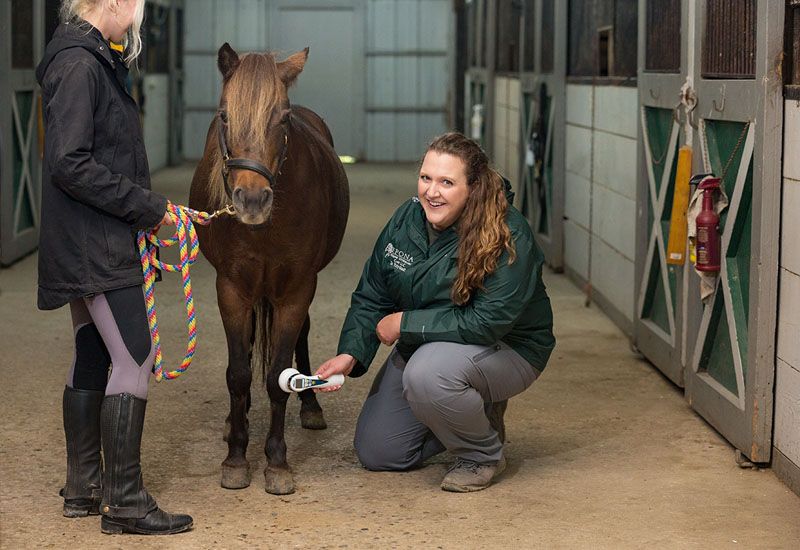Every little thing You Required to Understand About Equine Therapy for Mental Health And Wellness
Assessing the Effectiveness of Laser Treatment in Horse Therapy for Injury Recovery
The examination of laser therapy's efficiency in equine injury rehabilitation depends upon numerous elements, including healing time, pain reduction, and cells regeneration. Professional research studies suggest notable improvements in problems like tendonitis and osteoarthritis, attributed to enhanced cellular feature and raised ATP production. Veterinarians frequently observe remarkable results with laser treatment compared to traditional techniques, positioning it as an important aspect in equine treatment. The requirement for constant tracking and personalized therapy strategies can not be overstated. What particular clinical proof supports these insurance claims, and exactly how do vets carry out these methods in technique?

Understanding Laser Therapy
Laser therapy has actually ended up being an essential device in veterinary medicine, particularly in the therapy of equine problems. Known for its non-invasive nature and efficiency, laser treatment entails the application of certain wavelengths of light to promote cells repair work and reduce inflammation. This healing method is significantly preferred for its ability to increase the recovery process in steeds experiencing a variety of musculoskeletal injuries and chronic problems.
The primary device behind laser therapy is its capability to improve cellular features. When laser light passes through the skin, it is absorbed by mitochondria, the giant of cells, which leads to increased manufacturing of adenosine triphosphate (ATP) This biochemical energy increase facilitates cellular repair work and regeneration. Additionally, laser treatment promotes vasodilation, enhancing blood circulation and oxygen distribution to broken tissues, hence speeding up recuperation.
In equine medication, laser therapy is especially helpful for conditions such as tendonitis, osteoarthritis, and wound healing. The technique is admired for its pain-relieving properties, enabling steeds to restore mobility and feature extra swiftly. Veterinarians likewise value its minimal negative effects compared to other treatment modalities, making it a trusted and secure alternative for equine treatment.
Just How Laser Therapy Functions
To comprehend exactly how laser therapy functions, it is crucial to look into the interaction in between light power and biological cells. Laser treatment, likewise referred to as Low-Level Laser Treatment (LLLT) or photobiomodulation, utilizes certain wavelengths of light to pass through tissues and promote mobile processes. The system depends upon the absorption of photons by cell chromophores, largely within the mitochondria, which are essential for energy manufacturing.
Upon absorption, these photons cause a series of biochemical adjustments, enhancing mitochondrial function and bring about enhanced adenosine triphosphate (ATP) production. This rise in ATP increases cellular metabolism, promoting cells repair work and regeneration. In addition, laser treatment regulates inflammatory feedbacks by influencing cytokine levels and lowering oxidative anxiety, therefore relieving discomfort and swelling.
One more substantial element of laser treatment is its duty in enhancing microcirculation. The therapy advertises vasodilation, boosting blood circulation and oxygen delivery this content to broken tissues. This promotes the removal of mobile particles and sustains the proliferation of fibroblasts and collagen synthesis, important for wound recovery.
Medical Proof
The effectiveness of laser therapy in equine therapy has been substantiated with various professional researches, showcasing its healing prospective throughout a variety of problems. A study carried out by Turner et al. (2012) showed that equines treated with low-level laser treatment (LLLT) for tendon injuries displayed increased recovery contrasted to those receiving traditional treatments.
In a similar way, research study by Johnson and associates (2015) focused on equine muscle injuries, disclosing that laser treatment significantly accelerated muscle mass fiber regrowth and lowered muscle mass stiffness. Scientific evaluations have actually revealed that laser treatment can relieve persistent conditions such as osteoarthritis.
Veterinarian Insights
Vet professionals have actually progressively acknowledged the value of laser therapy in equine therapy, citing both empirical proof and firsthand experience. Dr. Jane Smith, a leading equine vet, keeps in mind that laser therapy has actually shown remarkable effectiveness in reducing inflammation and accelerating tissue repair. "In my method, I've observed faster healing times in horses treated with laser treatment contrasted to traditional techniques," she specifies. This view is echoed by Dr. John Doe, that stresses that laser treatment offers a non-invasive alternative with marginal side impacts, making it specifically fit for equine people.
Vets additionally value the flexibility of laser therapy. She points out that laser therapy can be customized to the certain needs of each equine, guaranteeing ideal outcomes.

Practical Considerations
A key facet of implementing laser treatment in equine treatment includes comprehending the useful factors to consider that ensure its efficiency and safety. It is important to choose the proper laser gadget, as various types vary in wavelength, power, and infiltration depth (Equine Therapy). Vets have to recommended you read be skilled in these parameters to tailor therapy protocols effectively per injury type
Moreover, the frequency and period of laser treatment sessions require careful planning to make best use of therapeutic benefits while decreasing any kind of prospective damaging effects. Constant surveillance of the equine's response to treatment can assist essential adjustments in the therapy regimen. Developing a secure you can try this out and regulated setting throughout treatments is likewise important to stop unexpected direct exposure to laser exhausts, which could harm both the horse and the trainer.
Training and certification of personnel providing laser therapy are vital to make certain correct method and to promote safety and security criteria. In addition, keeping exact documents of each session, consisting of laser setups and observed outcomes, is essential for examining the general performance of the therapy and for making data-driven decisions.
Final Thought
Laser treatment has actually arised as an effective modality in equine injury rehabilitation, providing substantial benefits in recovery time, discomfort alleviation, and cells recovery. For ideal outcomes, continuous tracking and individualized therapy procedures continue to be essential in leveraging the complete potential of laser therapy in equine care.